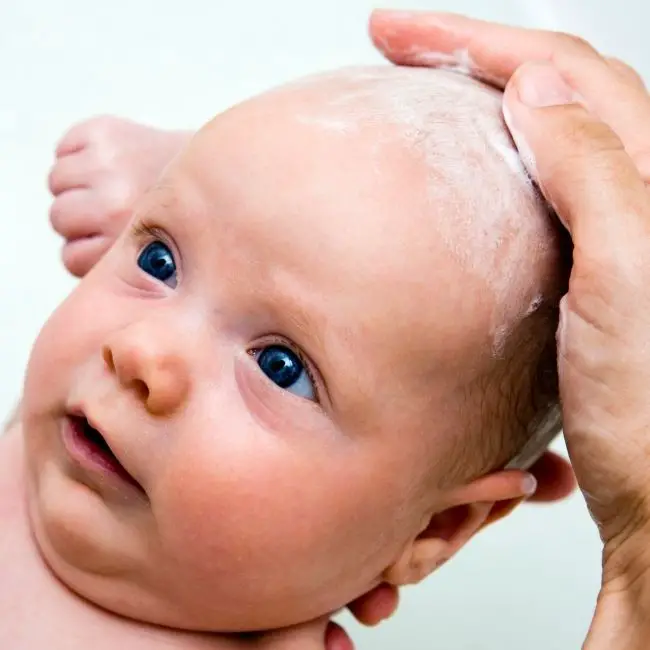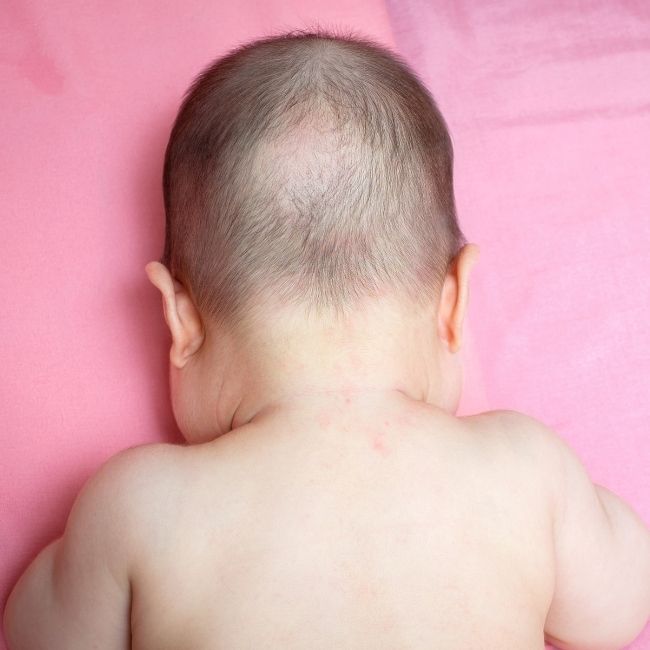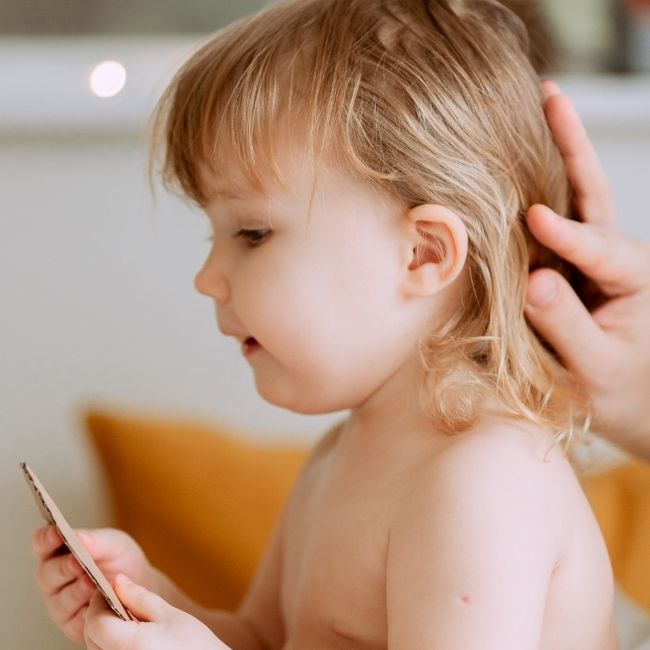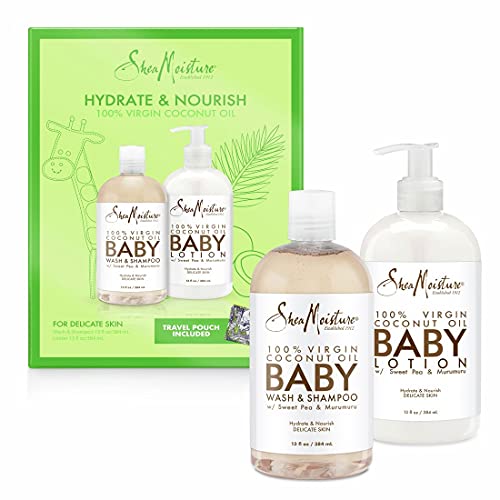If you’ve become a parent for the first time, or are a parent-to-be, it may surprise you to know that baby hair growth doesn’t come naturally for all littles. Indeed, baby hair growth can be a slow and begrudging process, much to the chagrin of unsuspecting parents. So, what can be done? Join us as we explore the many facets of how to grow infant’s hair.
How Long Does It Take For Baby’s Hair to Grow?
When do babies get a full head of hair?
Believe it or not, the answer to this one is up to genetics and will vary from child to child.
For some, a full head of hair may be present at birth, some of it even curly, yet for others, there may be no hair in sight.
Related Read:
Interestingly, this does not serve as a good predictor of how the baby’s hair will be in the future.
Even if your baby is born without hair or with hair that is very fine, that doesn’t mean he or she won’t have a thick head of hair within the first year or two. Conversely, some children won’t receive a full head of hair until they are 2-3 years old. Others, however, may be blessed with a full mane from birth.

Baby Hair Growth Stages
While it remains true that babies will incur hair growth at different ages and stages of life, it is also true that there tends to be a pattern to when and how baby hair grows.
Oftentimes, whatever hair the baby is born with will remain until the baby turns around 8-12 weeks. At this point, the baby will start to shed his or her hair and will grow thicker hair at around 3-7 months old.
This can be a challenging thing to watch for some parents, especially those whose babies were born with a full mane! Nevertheless, these growth stages are common and hair fall is often to be expected.
On the plus side, at around 2 years of age, you’ll likely begin to see your little sprout even thicker tresses to replace the old. This is your baby’s “adult hair”.
Slow Hair Growth in Toddlers
As with any physical conundrum that plagues children and adults, you’ll want to contact your local healthcare provider for concerns you have about slow hair growth in your toddler.
Nevertheless, there are a few things that may contribute to poor or inadequate hair growth in your little one. These include:
- Malnutrition
- Specific Nutritional Deficits
- Hair Pulling Initiated By the Child
- Weak or Fragile Hair Strands
- Improper Use of Hair Products
- Severe Fever
- Thyroid Dysfunction
- Infection
Of course, not all slowed hair growth is attributed to the above factors. Again, it is best to see a pediatrician about any concerns you have about slowed hair growth in your toddler if it really bothers you.
Baby Has Less Hair Volume
Just as some babies are born with more hair than others, it is also true that some babies have more volume in their strands than others.
In fact, many parents find their babies to have thin and fine hair for the majority of their infant life. It isn’t until around 2 years old that children begin to grow in their “adult-like” tresses, and even then, the road to thicker hair might be longer for some than it is for others.
It is important to also note the type of hair that the parents have because, in reality, this very well could be the type of hair the child ends up with. Thus, if both parents have fine and thin hair, it could be that the child will have thin hair for good, though it typically doesn’t stay as thin as it was at birth.
Baby Hair Not Growing Evenly
Sometimes you may notice that your child’s hair isn’t growing in evenly, even if it had once been before.
This, again, often has to do with hormonal shifts and sleeping positions for baby, and can undoubtedly be frustrating for parents.
Having said that, it is important to bear in mind that baby hair will change and will eventually even out over time, even if it does not seem like it will. The best course of action is to wait it out, while continuing to stimulate the scalp and properly care for existing hair strands.
If your baby’s hair isn’t growing evenly, don’t fret. Most baby hair will even itself out after some time. In the meantime, you can use hair accessories to hide the unevenness by using hats and headbands. But even these can cause a baby’s hair to grow uneven, so do so with caution.
Baby Hair Loss on Top of Head
Though baby hair loss on top of hair can be alarming to most parents, the truth is that it is normal and to be expected.
The reasoning behind hair loss differs from one child to another, but more often than not, it is due to changes in hormones, behavior and sleeping positions.
There are some babies that twirl or pull at their hair, in which case, bald spots may emerge. If the pulling becomes excessive, you may consider contacting your local health practitioner for help.
In most cases, however, hair loss in babies isn’t something to be worried about, and is actually quite common, especially on the back of the head.
How to Grow My Baby’s Bald Spot
Growing your baby’s bald spot will take time and patience, but it can be done.
Rest assured that, without you doing much of anything, your baby’s bald spots are likely to grow back in.
Nevertheless, you may consider massaging the bald spot a few times a day with a baby-safe hair oil to stimulate growth, and use a soft bristled brush to gently brush the bald area to get blood circulating which also helps with hair growth.
Moreover, you may consider changing your child’s sleeping position, but ONLY when it is age appropriate to do so.
Babies often experience bald patches as a result of having their head rub against their bedding for long periods of time at night and during daytime naps.
Children under a year should be sleeping on their backs, but once the baby has cleared this milestone, you will likely notice the hair that was lost begin to grow back in.

When does baby hair texture change?
Baby hair texture can change in as little as a few weeks, all the way up until your child is 2-4 years old. This varies a lot, and can be dependent on a variety of factors. But when all is said and done, you’ll likely notice that your child has thicker, fuller and more voluminous locks by the age of 2, and certainly by their school-aged years.
Bear in mind that baby hair textures can vary and will be largely dependent upon the genetics and nationality of the child. Thus, hair texture changes will look different and will come at different times in life for each child.
How to Make Toddler Hair Grow Thicker
How to Make My Daughters Hair Grow Faster
There’s nothing like a wild head of long and luscious locks on your daughter’s head, but what happens when hair growth is a little slower than you’d hope?
First, don’t panic. Depending on the age of your child, he or she may develop longer and thicker locks as time goes on.
Still, if you are worried and want to know of ways to get your daughter’s hair to grow faster, you may consider the following:
- Massaging the Scalp: Using your fingers to gently massage the scalp can improve blood circulation and cause hair to grow faster.
- Know Your Baby’s Hair Type: Particularly when it comes to kinky and coily curls, knowing your baby’s hair type, and how to properly take care of it is key. You may have heard of 4c curls or high versus low porosity hair. Believe it or not, these categories, especially for kinkier hair textures, are important to understand. Each curl pattern and porosity level will require different treatment. So be sure to do your research if you aren’t finding that your little one’s hair is growing as fast as you’d wish.
Fastest Way to Grow Baby Hair
The fastest way to grow baby hair is to brush baby’s scalp, even if there is no hair there. Antother is also to use nourishing ingredients on baby’s hair to keep it moisturized.
You’ll also want to follow up with a baby-safe shampoo and conditioner as needed. For some hair types that may be every few days. For other hair types it may be once a week.
There are also some hair products, such as Baby Don’t Be Bald that will assist with the hair growth process.
Also, be sure to keep a close watch on the baby’s diet. Ensure that he or she is receiving proper nutrition daily with plenty of vitamins.

Which oil is best for baby hair growth?
Given the sensitive nature of baby skin and hair, it is easy to understand why some parents might be a little apprehensive when it comes to trying new oils on baby’s hair. Thankfully, with a little research and extra caution, there are several oils that can help stimulate baby hair growth when applied to the strands and scalp.
Castor Oil For Baby Hair Growth
Castor oil has long been hailed as a champion in causing tresses to grow long and healthy. This does that by increasing blood flow to the scalp. And though castor oil is generally regarded as safe for little ones, it is still a good idea to refrain from putting castor oil anywhere near your baby’s eyes, nose, ears, lips or anus.
You should also be aware that castor oil seeds are toxic. They should NOT be ingested by babies, children or adults. To be safe, we’d recommend using a castor-oil containing hair care solution such as Mom & World Baby Hair Oil With Organic Cold Pressed Natural Oils to begin with. You may later graduate to using pure castor oil with your pediatrician’s approval.
Coconut Oil for Baby Hair Growth
Although coconut oil in its pure form is regarded as safe for babies, it can help to know that the product you are using is specifically marked as suitable for use on baby skin and hair.
Cocobelle Baby is organic coconut oil that can be used on both baby skin and hair. Because coconut oil is chock full of vitamins and fatty acids to nourish your baby’s hair and scalp, it is the optimal pick for encouraging hair growth and a healthy scalp.
One thing you should be cautious about, however, when using coconut oil on your baby’s hair and scalp is the fact that it may clog your little one’s pores. It may cause unwanted bumps on your child’s forehead, cheeks and face.
Wild Growth Hair Oil For Babies
The votes are in, and certainly, Wild Growth Hair Oil is a top contender in making hair luscious, full and long. But is it safe for baby? A quick look at the ingredients and it doesn’t seem that the product is particularly threatening.
However, you may want to do a skin test on your baby before using it and discontinue use if you see any irritation occur. If you’re still unsure, you may wish to speak to a pediatrician about whether or not this product is a good fit for your baby.
Other oils and ingredients that may prove beneficial for baby hair include shea butter, grapeseed oil, sweet almond oil and more. Be careful with olive oil though because, contrary to popular belief, it may have negative effects on sensitive baby skin.
Other Products That Help Grow Baby’s Hair and Products That Help Toddler’s Hair Grow
Aloe Vera For Baby Hair Growth
Because aloe vera is known to cleanse the scalp, it also prepares the scalp to receive more nutrients. For this reason, aloe vera is a great pick for hair growth in babies.
While it may not be particularly moisturizing in and of itself, it does nourish the scalp for healthier and more robust hair growth. And though aloe vera is regarded as safe for babies, you may consider trying Johnson and Johnson Baby Oil infused with aloe and Vitamin E. It is mostly for the skin, but may be able to be used on the hair. Simply apply a little to the back of your baby’s head and wait 24 hours to ensure there is no reaction.
Otherwise, you can use pure aloe vera by squeezing the jelly from the actual plant or selecting a purer aloe vera gel that is free from harmful chemicals.
Baby Hair Growth Shampoo
There aren’t a ton of hair shampoos out there specifically marketed for hair growth in babies. But there are a few shampoos out there that are gentle enough for baby’s scalp. They’re also nourishing enough to encourage hair growth.
For example, Shea Moisture 100% Coconut Oil Shampoo Wash is a great shampoo for sensitive baby skin that also contains fatty-acid and vitamin-rich coconut oil. Just be sure to watch for rash in your baby no matter what you use. Baby skin is very sensitive, and as such, it may react negatively even to products marketed as for baby or “gentle”.
Baby Hair Growth Conditioner
Using a conditioner in unruly or hard to grow infant and baby hair can aid in the growth process. It works to make hair softer, more nourished and easier to manage, especially after a particularly stripping shampoo. Thus, it is easy to see how conditioner would play a vital role in spurring your little one’s tresses towards better growth.
Our favorite in this category for newborns and babies is Noodle and Boo Leave-In Conditioning Hair Polish. This “no tears” formula works to improve manageability and add shine. The sunflower seed oil and green tea work to improve the health of baby’s hair from the scalp.
Healthy Baby Hair Growth Tips
Food For Baby Hair Growth
What food can I feed my baby to stimulate hair growth?
A well-balanced diet is absolutely crucial for your baby to grow healthy and strong. But it is also crucial for helping baby hair to grow to their full potential.
In order to make this happen, we recommend feeding baby foods high in protein, iron, Vitamin A, Vitamin B, Vitamin D and zinc. For those eating solid foods, dark leafy vegetables – such as steamed spinach – and finely chopped proteins – like chicken or hard-boiled eggs – are great foods to start with.
Breast Milk for Hair Growth
Breast milk may help with hair growth in young babies. But there isn’t any extensive research or evidence that shows a direct correlation.
Having said that, because breast milk is packed with nutrients, including much of the vitamins and minerals we mentioned in the above section that encourage hair growth, we know that breast milk should be an integral part of every baby’s diet as long as the mother is able and willing to provide it.
How to Make Baby Hair Grow in Womb
While there isn’t much control that you’ll have over what happens to your baby’s hair in the womb, there may be certain foods you can eat that might aid in the process.
For example, eating proteins – such as eggs – and taking in nuts and yellow and orange fruits can cause your baby to grow hair in the womb.
But even if you do all this and your baby is still born bald, don’t be surprised…much of your baby’s development, and especially hair, comes down to genetics.
When to Wash Newborn Hair for First Time
It’s okay to rinse your baby’s hair and skin with pure water from the moment of birth. But you should never wash your baby’s hair or skin with any fragranced or perfumed products. When they are around 4-6 weeks old, you can use un-fragranced shampoos and soaps. But be careful, and always discontinue use if you see skin irritation.
For more tips, talk with your pediatrician or nurse for information on when and how often to clean your newborn’s skin and hair.
Other Baby Hair Growth Tips
In addition to the tips above, here are a few other things to consider while trying to grow your baby a full head of hair:
- Massage: Consider gently massaging your baby’s scalp to promote blood circulation which will help stimulate your baby’s hair follicles.
- Use Tools: Use a soft-bristled brush to gently brush your baby’s scalp. Do this while also focusing on your baby’s bald spots as you brush. This, too, promotes blood flow and allows your baby’s hair follicles to become stimulated.
- Avoid the Wrong Products: Remember, the younger your baby is the more susceptible he or she will be to harsh, pore-clogging or otherwise irritating products. Opt for water only during the newborn phase. Or if you must use a product, use one that is fragrance-free or gently scented to avoid irritating your baby’s skin. Never use products with heavy fragrances. Avoid essential oils in baby products, even if the advertisements for them claim them as being “gentle” on baby skin.
- Focus on Diet: Aside from what you should and shouldn’t put on your baby’s hair, it is equally important what you put into your baby’s belly to begin with. Always focus on a healthy and well-balanced diet for your little one. A head full of healthy hair is a secondary benefit to feeding your baby nutritiously.
How to Make Baby’s Hair Grow Faster: Only a Few Steps Required
To close, making your baby’s hair grow faster may not be completely within your control. But there are things you can do to aid the process. We hope we’ve given you enough tips and product recommendations to get your baby’s tresses back on track! Just be sure to continue doing your research and don’t be afraid to switch things up if your baby’s hair growth isn’t progressing as planned. And, as always, consult your pediatrician for further advice when needed.
Check out more baby care tips on the Infant Empire blog!
Lynn
Lynn is a freelance writer, a wife, and a mother of two beautiful kids. Lynn started Infant Empire with the aim of making parenting easier for fellow mums and dads. She believes the parenting tips provided here will be of great help to all parents.Recommended Reading
Baby Cold Hands While Sleeping: What Should Baby Wear to Sleep
All in all, if your baby has cold hands and feet, it could be an indicator that he or she is chilly but not always.
Best Fetal Doppler for early pregnancy
One major cause of anxiety among mothers to be is not feeling the baby kick as often as they are used to. A few years ago, the only way to ease this anxiety was to have the fetal heart rate checked in the OB’s office as soon as possible
Toiletries For Baby: What Toiletries Does Your Baby Need?
When having a baby, it's crucial that you have the right things on hand to keep your little one's hygiene up to par.
Baby Hair Color Change: What Age Does Baby’s Hair Color Change?
In this post, we will explore the question of, “what age does baby hair color change” as well as why these changes happen.
Jumperoo Age: What Age Can a Baby Go in a Jumperoo: Jumperoo Safety For Your Child
We’ve set out to answer these often-asked questions about the ever-popular Jumperoo and other baby jumper devices.
How to Tell If Baby Has Fever Without Thermometer and When to Worry
Join us as we delve into the various ways you can determine if your baby has a fever without the use of a thermometer.





